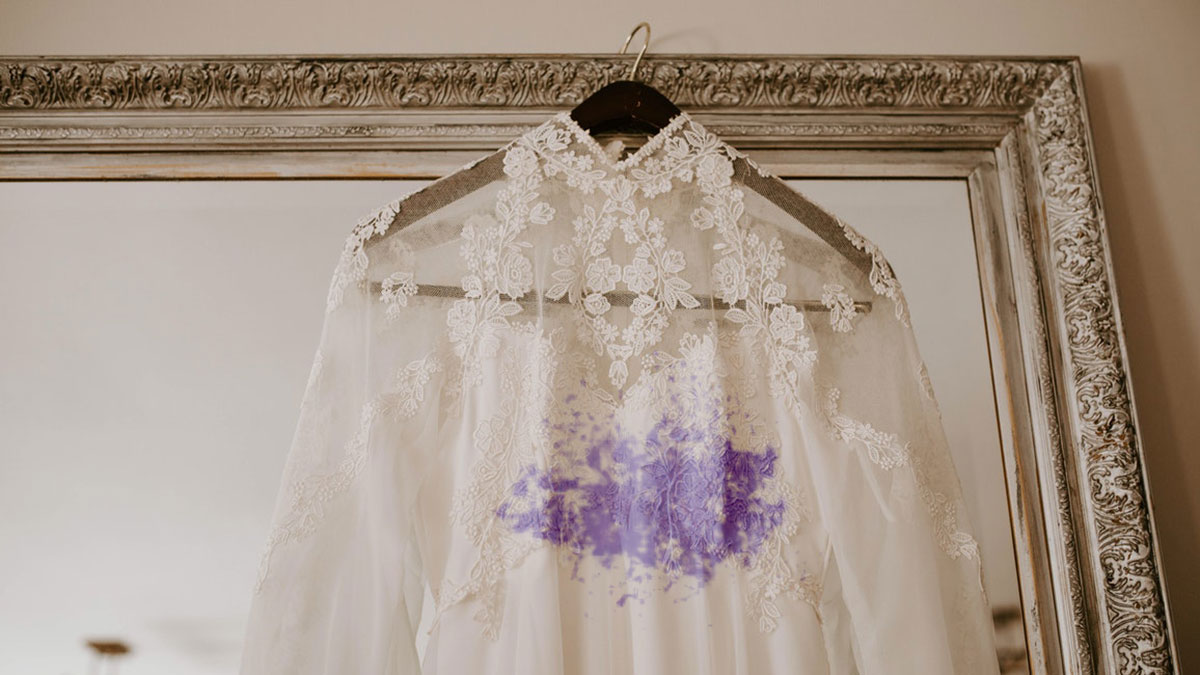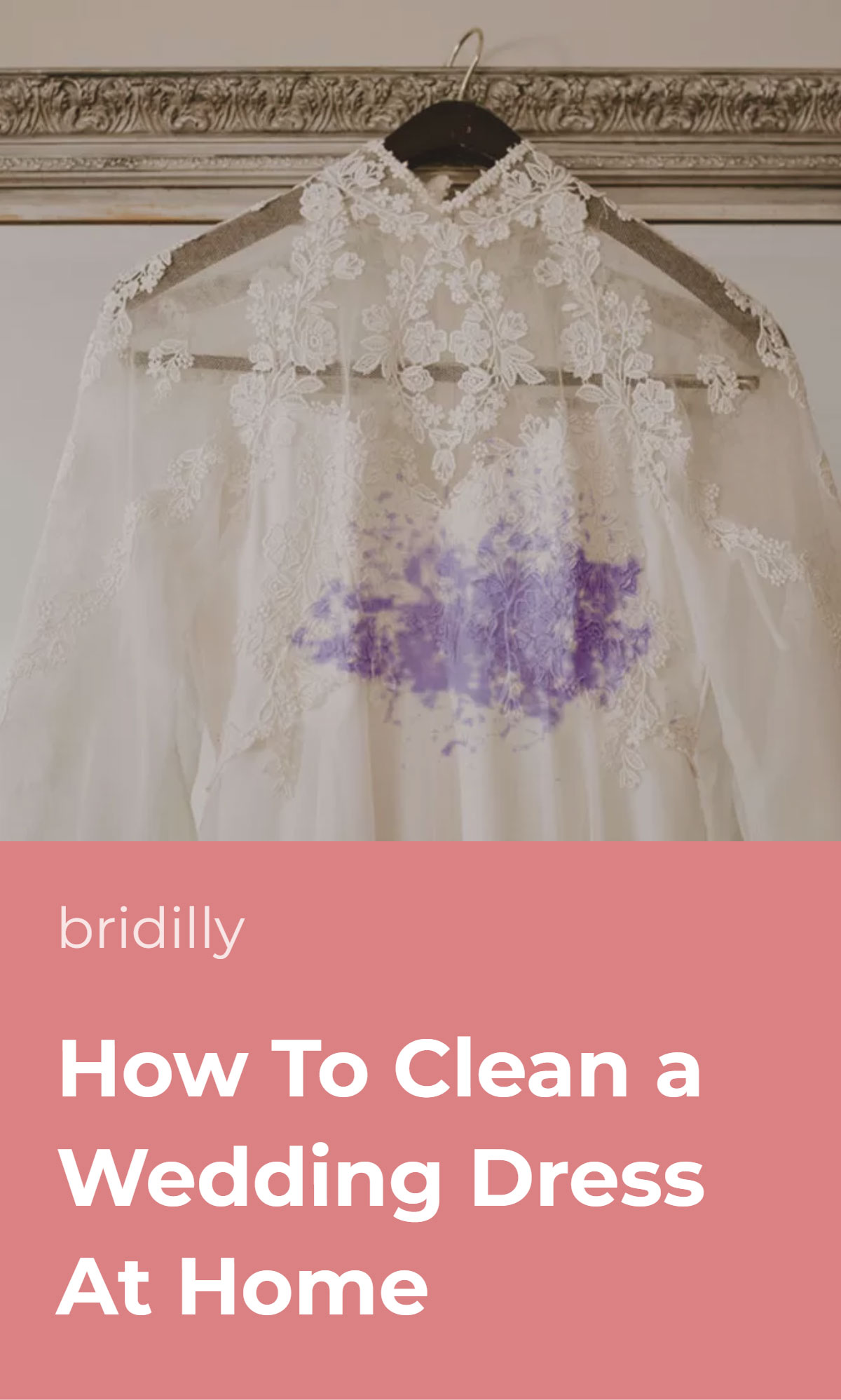Although many wedding dresses should only be dry-cleaned, brides commonly wonder how to clean a wedding dress at home.
After all, trusting such a dear to the heart piece to someone you don’t know is rather risky.
DIY wedding dress cleaning requires a high degree of attention, a sense of responsibility, and, preferably, a bathtub. However, it isn’t impossible.
Knowing your wedding dress fabric is vital to pick the correct cleaning method. We don’t want to cause more harm than good, right? Your dress may be either dry cleaned, washed in a machine, or by hand.
Challenges don’t end with cleaning, though. Correct drying and storing are just as essential to preserving your wedding dress in its best possible state.
Table of Contents [show]
Consider the Fabric & Design
Different wedding dresses require different cleaning approaches.
Simple cotton dresses are washing-machine friendly, whereas some intricate designs can only be dry-cleaned. Thus, inspecting the dress fabric and design is the first step.
Any embellishments and other intricate elements will complicate the cleaning process. If you can take them off, do it to prevent damaging them. Otherwise, consider spot cleaning or opt for professional dry cleaning.
Of course, the fabric plays an important role, too. Silk is among the most popular wedding dress fabrics – it’s light, pleasant to the skin, and luxurious. And despite appearing delicate, natural silk is very robust.
If your silk wedding gown is minimalistic, you can safely wash it on a delicate mode in the washing machine.
However, this doesn’t apply to artificial silk, which must only be washed in cold water by hand to prevent wrinkling.
Generally, synthetic fibers such as polyester are well suitable for machine cleaning.
But refrain from it if your dress is made from organza or nylon tulle. These fabrics may have an altered texture after any cleaning, even professional dry cleaning.
Another popular wedding dress fabric is chiffon. Handwashing is the safest washing method for such a delicate fiber. Avoid wringing the dress to prevent it from wrinkling.
In short, you should carefully read the label to determine your wedding dress fabric. Even if the label doesn’t mention any washing instructions, finding out the material is a good start.
If you’ve cut the label off, you may contact the bridal salon you’ve purchased the dress from. They will likely carry the same or similar dress and will be able to tell you the composition.
Spot Clean vs Full Clean
Some dresses don’t require a full clean, and others may simply not be suitable for a full clean.
If your dress has an intricate bodice design or only has one stain, consider spot clean. Sometimes, spots can be removed right during the wedding reception.
Of course, even with a wedding dress spot clean, you should consider the fabric and the stain type. Strive to avoid chemical agents whenever possible.
For protein-based stains such as blood, eggs, or milk, use cold water and a bit of salt or baking soda.
Water mixed with dish soap effectively removes juice, wine, liquor, cola, tea, and oil-based stains. If the stain is old, you may have to use bleach – but only if the fabric allows it.
Earth stains can be removed without any agents – simply rub them with a dry towel or cloth. However, if your dress has a grass stain, it is better to leave it for a professional.
The last but not least annoying stain type is makeup, especially lipsticks. Since all lipsticks have a different ingredient list, there’s no universal cleaning solution. Some matte lipsticks are impossible to remove.
One helpful piece of advice is to blot the spot, not rub it. Hopefully, you’re reading it prior to the event, not after you’ve already got a red lipstick stain on the dress.
If your wedding dress has multiple layers, thoroughly inspect each one. Sometimes, stains hidden under the skirt layers may be very noticeable when you move or sit.
Choose the Right Cleaning Agents
The most common clothes cleaning agent is detergent, either powder or liquid. It’s a simple all-in-one solution convenient for daily clothes but not always suitable for delicate wedding dress fabric.
If you still decide to use a detergent to clean your dress, choose the liquid form – it’s gentler to the fabric.
Never use detergents for taffeta, acetate, and fur (not a common material in bridal wear, but better safe than sorry).
Unlike detergents, soaps can be made from natural ingredients and tend to cause less skin irritation.
However, soap may form a deposit on white fabric, causing it to look dull and greyish. Furthermore, soaps aren’t as effective for cleaning synthetic fibers.
If you intend to use bleach, learn the difference between chlorine and oxygen bleach. The former shouldn’t be used with silk, spandex, and lycra. The former is more friendly on fibers but may still be too harsh for thin fabrics.
As for stain removers, each has a different ingredient list. Carefully read the label to determine whether it’s suitable for your wedding dress.
Generally, natural remedies such as soda and vinegar are preferable for wedding dress cleaning.
Soaking
Wedding dress soaking isn’t a mandatory step, but it’s highly effective for dirty hemlines.
Fill your bathtub with warm but not hot water and hang your dress above it with the hem submerged in water. You may mix the water with a bit of a cleaning agent or dish soap.
Leave the hem to soak for some time, depending on the case severity. Then, gently massage the hem with hands to rub in the soapy water.
Don’t rub too vigorously to prevent damaging the fabric, and make sure to clean every layer.
Drain the soapy water and rinse the hem thoroughly with clean water when the dress is clean. Then, leave it to dry.
Bleach
Sometimes, bleaching is the only option. That’s especially relevant for vintage wedding dress cleaning. Discoloration and compromised fabric integrity are only some of the problems typical with such dresses.
Cotton and other natural fibers are the only fabrics you may attempt bleaching at home.
Choose an oxygen-based agent and read the instructions carefully. Make sure to regularly check the fabric lightness throughout the process and carefully rinse it afterward.
Opt for professional wedding dress bleaching if the fabric is fragile and delicate, or you notice rips or tears on the material.
Dry cleaning experts have agents unavailable for purchase in regular stores that will be gentler for your dress but require special handling.
Dry
Correct wedding dress drying is vital, yet women often neglect it. Most wedding dresses must be “line” dried, meaning they shouldn’t be folded because some fabrics can’t be ironed, and folding may create wrinkles.
However, hanging the dress isn’t always a good idea. If the skirt is heavy, its weight may pull the dress down and damage it. Instead, place your dress on a drying rack, ensuring even weight distribution.
If you don’t have a large enough drying rack, you may place the dress on a clean towel or sheet. Never dry your dress on bare wood, as it may leave stains on the white fabric.
Things to Avoid
In most cases, cleaning a wedding dress in a washing machine isn’t the best idea.
It’s only possible if your wedding dress fabric is washing machine-friendly, for instance, cotton or polyester, and the dress doesn’t have many decorative details.
If the dress has embellishments, lace ornaments, or delicate draping, the washing machine may damage them. Furthermore, some fabrics used in wedding dresses are extremely gentle and tend to shrink even from moderately warm water.
However, you can wash a minimalistic wedding dress in a washing machine if you follow the instructions on the label. Consider using a wash bag for added protection.
The sad truth is, handing your wedding dress to a dry cleaner isn’t the ultimate solution either. Make sure the chosen professional has experience cleaning wedding dresses.
Squeezing the fabric before drying it is among the top things to avoid when cleaning a wedding dress.
That’s especially relevant for materials that can’t be ironed. Instead, put the fabric flat in the bathtub and gently push the water out of it.
Some stains require immediate action, so don’t wait to clean your wedding dress until your first anniversary. The longer you wait, the less likely you are to successfully remove wine, grass, or lipstick stains.
Rubbing a stain is another wedding dress killer. Be it dirt, makeup, or oil, never rub the spot – it will only get bigger and harder to remove.
Instead, try to cover it with your bouquet or hair on your special day and clean it properly afterward.
Incorrect storage of your wedding dress could lead to it getting dirty even if it was spotless right after the event.
Keep your dress in a large box in a dry place. Don’t store it on a hanger unless the skirt is really light, and don’t stash the box in an attic.

















No Comments Add one
Leave a Comment